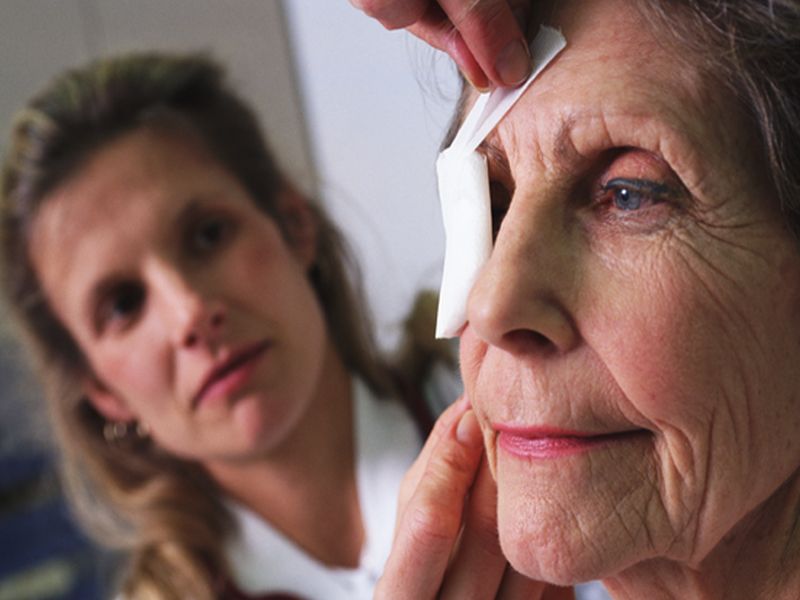
Monday, February 29, 2016

MONDAY, Feb. 29, 2016 (HealthDay News) -- People with diabetes are at risk for blurred vision or even a loss of vision from a condition called macular edema.
Three drugs for the disease -- Avastin, Eylea and Lucentis -- vary widely in price, but new research suggests all work equally well for patients with mild vision loss.
However, when diabetic macular edema leads to more severe vision loss, researchers found Eylea to be the better choice.
The study, funded by the U.S. National Eye Institute (NEI), "will help doctors and their patients with diabetic macular edema choose the most appropriate therapy," study lead author Dr. John Wells said in an institute news release.
"The study suggests there is little advantage of choosing Eylea or Lucentis over [much cheaper] Avastin when a patient's loss of visual acuity from macular edema is mild, meaning a visual acuity of 20/40 or better," Wells explained.
"However, patients with 20/50 or worse vision loss may benefit from Eylea, which over the course of the two-year study outperformed Lucentis and Avastin," said Wells, a retinal specialist at the Palmetto Retina Center in Columbia, S.C.
As the researchers explained it, diabetic macular edema can cause fluid to leak from abnormal blood vessels in the retina. This can result in blurry vision or vision loss. Drugs used to treat the condition are injected into the eye and work by blocking a substance that can trigger the leakage.
Cost is a factor, too. Although they work in similar ways, the three drugs vary dramatically in price. Based on Medicare's pricing guidelines, the per-injection cost for Eylea is $1,850, $1,200 for Lucentis and only $60 for Avastin, the news release noted.
The two-year clinical trial compared the effectiveness of the three drugs in 660 patients with diabetic macular edema. Patients were treated at 89 sites across the United States.
The patients averaged 61 years of age and had type 1 or type 2 diabetes for an average of 17 years. None of the patients had vision better than 20/32.
Half of the patients had already experienced "mild to moderate" vision loss, the researchers said. The rest had moderate to severe vision loss -- 20/50 or worse vision. Patients were randomly assigned to receive one of the three drugs, and were checked regularly over the next two years.
Most patients received monthly injections for the first six months. After that, they received additional injections of the drug they were assigned until their condition resolved or their vision stabilized and stopped improving.
Patients that experienced a relapse of macular edema after their treatment was suspended resumed receiving their injections. Any whose macular edema persisted after six month of injections were given laser treatment -- the standard treatment before newer drugs for the condition became available.
According to Wells and colleagues, all three drugs performed similarly among participants with mild vision loss when the study began. On average, participants' vision improved from 20/40 vision to 20/25, the study showed.
"This rigorous trial confirms that Eylea, Avastin, and Lucentis are all effective treatments for diabetic macular edema," NEI director Dr. Paul Sieving said in the news release. "Eye care providers and patients can have confidence in all three drugs."
Patients with moderate to severe vision loss also reported significant improvements in their ability to see. Halfway through the study, however, Eylea outperformed Avastin and Lucentis. By the two-year mark, Eylea and Lucentis produced similar gains in vision, the team found.
The researchers reported that the average visual acuity was 20/32 to 20/40 among participants in each treatment group by the end of the study.
Patients needed about the same number of injections over the course of the study, regardless of the type of drug taken, the study authors said. On average, the participants were given nine injections during the first year of the study and five more injections the following year.
The need for laser treatment varied. Of the patients taking Eylea, 41 percent needed laser treatment. In contrast, 64 percent of the patients in the Avastin group and 52 percent of those in the Lucentis group also needed laser treatment.
Two experts said the study provides important guidance for patients and physicians.
"There are 7.7 million diabetic patients in the United States with approximately 750,000 of those suffering from diabetic macular edema," said Dr. Mark Fromer, an ophthalmologist at Lenox Hill Hospital in New York City. "This study will help both retina specialists and patients alike understand the benefits of choosing these drugs in the treatment of diabetic macular edema."
Dr. Nazanin Barzideh is chief of vitreoretinal surgery at Winthrop-University Hospital in Mineola, N.Y. She said that the study findings were in line with her experience.
"I have seen my diabetic patients with macular edema having a better response to Elyea compared to other [similar] drugs available on the market, especially those patients with severe visual acuity," she said.
The study was published online Feb. 27 in the journal Ophthalmology.
SOURCES: Mark Fromer, M.D., ophthalmologist, Lenox Hill Hospital, New York City; Nazanin Barzideh, M.D., chief, vitreoretinal surgery, division of ophthalmology, Winthrop-University Hospital, Mineola, N.Y.; U.S. National Eye Institute, news release, Feb. 27, 2016
HealthDay
Copyright (c) 2016 HealthDay. All rights reserved.
- More Health News on:
- Medicines




























.png)












No hay comentarios:
Publicar un comentario